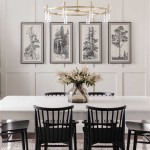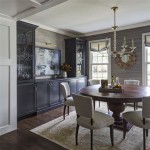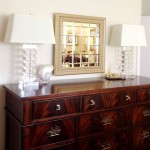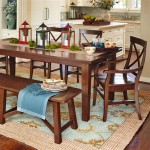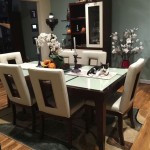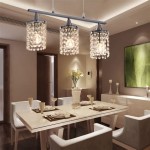Paint Dining Room Table Ideas: A Comprehensive Guide to Transforming Your Space
The dining room table often serves as the heart of the home, a gathering place for meals, conversations, and memories. Over time, a dining room table can become worn, outdated, or simply no longer fit the evolving aesthetic of the space. Instead of replacing the entire table, painting it offers a cost-effective and creative solution to refresh the dining area and inject personality into the home. This article will explore various paint ideas for dining room tables, covering everything from preparation to techniques, and highlighting considerations for durability and style.
Preparation is Key: Setting the Stage for a Lasting Finish
Before embarking on the painting process, proper preparation is crucial for ensuring a smooth, durable, and aesthetically pleasing finish. This involves several steps designed to clean, repair, and prime the table surface.
First, thoroughly clean the dining room table. Remove any existing debris, crumbs, or dust with a dry cloth or vacuum. Next, use a mixture of warm water and mild dish soap to scrub the table surface. This will remove grease, grime, and any lingering food residues. Rinse the table with clean water and allow it to dry completely. Drying time can vary depending on the humidity and ventilation in the room.
Inspect the table for any imperfections such as scratches, dents, or chips. These imperfections should be addressed before painting. Use wood filler to fill any gaps or cracks, following the manufacturer's instructions for application and drying time. Once the wood filler is dry, sand it smooth with fine-grit sandpaper (around 220-grit) to blend it seamlessly with the surrounding surface.
Sanding the entire table surface is a critical step in the preparation process. Sanding creates a slightly rough texture that provides better adhesion for the paint. Use medium-grit sandpaper (around 120-grit) to sand the table, paying attention to edges, corners, and areas with existing finishes. Sand in the direction of the wood grain to avoid creating unsightly scratches. After sanding, remove all sanding dust with a tack cloth or a damp cloth. Allow the table to dry completely before proceeding to the next step.
Applying a primer is essential for achieving a uniform and durable paint finish. Primer helps the paint adhere better to the table surface, prevents staining, and creates a consistent base color. Choose a primer that is specifically designed for the type of material your table is made of (e.g., wood, laminate, metal). Apply the primer in thin, even coats, using a brush, roller, or spray gun, depending on the size and complexity of the table. Allow the primer to dry completely according to the manufacturer's instructions before applying the paint.
Exploring Paint Options and Techniques: Achieving the Desired Aesthetic
Selecting the right type of paint is crucial for achieving the desired aesthetic and ensuring the longevity of the finish. Various paint types offer different properties, such as durability, sheen, and ease of application. Consider the intended use of the table and the desired style when choosing the paint. Proper application techniques are also important for achieving a professional-looking finish.
Latex paint is a popular choice for painting dining room tables due to its durability, ease of cleaning, and low odor. It is water-based, making it environmentally friendly and easy to clean up with soap and water. Latex paint is available in a wide range of colors and sheens, from matte to high-gloss. Consider using a satin or semi-gloss sheen for dining room tables, as these sheens are more durable and easier to clean than matte finishes.
Oil-based paint offers excellent durability and a smooth, even finish. However, it has a strong odor and requires mineral spirits for cleanup. Oil-based paints are also slower to dry than latex paints. Due to these factors, latex paint is generally preferred for most dining room table painting projects.
Chalk paint is a popular option for creating a distressed or vintage look. It has a matte finish and adheres well to most surfaces without requiring extensive preparation. Chalk paint can be easily sanded to create a worn or aged appearance. However, it typically requires a sealant or wax to protect the finish from scratches and stains.
Milk paint is another option for creating a vintage or rustic look. It is a natural, non-toxic paint made from milk protein, lime, and pigment. Milk paint has a matte finish and can be easily distressed. It is also very durable and resistant to chipping and fading. However, milk paint can be more challenging to apply than other types of paint and may require multiple coats to achieve full coverage.
When applying paint to the dining room table, use smooth, even strokes. Avoid applying too much paint at once, as this can lead to drips and runs. Apply multiple thin coats of paint, allowing each coat to dry completely before applying the next. Sand lightly between coats with fine-grit sandpaper to create a smooth surface for the next coat of paint to adhere to. This process helps to create a durable and professional-looking finish.
Consider using a brush for detailed areas and a roller for larger, flat surfaces. A spray gun can be used for achieving a smooth, even finish, but it requires more skill and equipment. Always follow the manufacturer's instructions for drying times and application techniques.
Inspiration and Ideas: Transforming Your Dining Room Table
The possibilities for painting a dining room table are endless. From classic and elegant to bold and modern, a painted dining room table can transform the entire space. This section will explore various color schemes, design ideas, and finishing techniques to inspire your next painting project.
A classic white dining room table is a timeless choice that complements various interior design styles. White creates a bright and airy feel and can be easily paired with different chairs, linens, and accessories. Consider using an off-white or cream color for a warmer and more inviting look.
For a more dramatic look, consider painting the dining room table a bold color such as navy blue, emerald green, or deep red. These colors can add a touch of sophistication and personality to the dining room. Pair the bold table with neutral chairs and accessories to create a balanced and harmonious look.
A two-toned dining room table can add visual interest and create a focal point in the room. Consider painting the table top a different color than the base or legs. For example, a white table top with a dark wood base can create a classic and elegant look. Alternatively, a brightly colored table top with a neutral base can add a playful and modern touch.
Distressed finishes create a vintage or rustic look. This can be achieved by sanding the paint in certain areas to reveal the underlying wood. Consider distressing the edges, corners, and areas that would naturally wear over time. Seal the distressed finish with a clear coat of varnish or wax to protect it from further wear and tear.
Stenciling adds a decorative element to the dining room table. Use stencils to create patterns, designs, or motifs on the table top or legs. Consider using a contrasting color for the stencils to make them stand out. Seal the stenciled design with a clear coat of varnish to protect it from scratches and stains.
Consider adding a protective top coat to prevent scratches, stains, and water damage. Polyurethane is a durable and water-resistant top coat that is available in various sheens. Apply multiple thin coats of polyurethane, allowing each coat to dry completely before applying the next. Sand lightly between coats with fine-grit sandpaper to create a smooth surface.
Epoxy resin is another option for creating a durable and glossy top coat. Epoxy resin is self-leveling and creates a thick, protective layer that is resistant to scratches, stains, and heat. However, epoxy resin can be more challenging to apply than polyurethane and requires careful mixing and pouring techniques.
Wax provides a soft, matte finish and adds a protective layer to the painted surface. Apply wax with a cloth or brush and buff it to a smooth sheen. Wax is not as durable as polyurethane or epoxy resin, but it is easier to apply and maintain. Reapply wax periodically to maintain the protective layer.
Hardware upgrades can complement the freshly painted table. Consider replacing the existing hardware with new knobs, pulls, or hinges that match the style and color of the table. Choose hardware that is made of durable materials such as metal or ceramic.
Chair pairings are essential for completing the look of the dining room. Consider pairing the painted dining room table with chairs that complement the style and color. Mix and match different chair styles to create an eclectic and unique look. Consider painting the chairs to match or complement the table. Upholstered chairs can add comfort and style to the dining room.
By carefully considering these ideas and techniques, individuals can transform their dining room table into a statement piece that reflects their personal style and enhances the overall aesthetic of the dining room.

Colours To Paint Your Dining Room Wall Annie Sloan

7 Paint Ideas To Transform A Dining Table Eatwell101

180 Painted Dining Set Ideas Decor Furniture

The Best Creative Painted Table Ideas Jennifer Rizzo

Dining Room Table Makeover

The Best Way To Paint A Dining Table And Chairs Confessions Of Serial Do It Yourselfer

Affordable Kitchen Table Makeover With Oops Paint Midwest Life And Style Blog

7 Ways To Paint Your Dining Table Houzz

Painted Kitchen Table Ideas

Painted Furniture Ideas And Inspiration Beamin Moore

